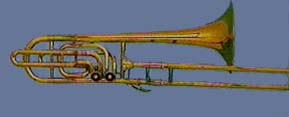The Trombone

The trombone emerged as a variation of the medieval trumpet when the slide, in the form of a U-bend, was created (mid-15th century), immediately producing an efficient and unique low brass instrument capable of playing all chromatics. From that time to the present, the instrument has consisted fundamentally of a bell section including attached inner slides, outer slides, and mouthpiece, the tube being cylindrical up to a gradual expansion toward the bell.
| Example waveforms | Trombone Details |
Brass concepts
Brass instruments
Musical instruments
| HyperPhysics***** Sound | R Nave |